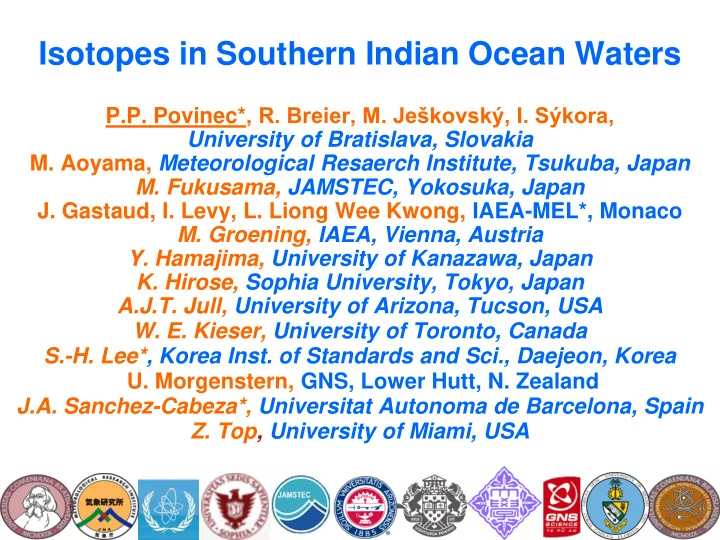

Isotopes in Southern Indian Ocean Waters P.P. Povinec* , R. Breier, M. Ješkovský, I. Sýkora, University of Bratislava, Slovakia M. Aoyama, Meteorological Resaerch Institute, Tsukuba, Japan M. Fukusama, JAMSTEC, Yokosuka, Japan J. Gastaud, I. Levy, L. Liong Wee Kwong, IAEA-MEL*, Monaco M. Groening, IAEA, Vienna, Austria Y. Hamajima, University of Kanazawa, Japan K. Hirose, Sophia University, Tokyo, Japan A.J.T. Jull, University of Arizona, Tucson, USA W. E. Kieser, University of Toronto, Canada S.-H. Lee*, Korea Inst. of Standards and Sci., Daejeon, Korea U. Morgenstern, GNS, Lower Hutt, N. Zealand J.A. Sanchez-Cabeza*, Universitat Autonoma de Barcelona, Spain Z. Top, University of Miami, USA
Isotope tracers of oceanic processes • 2H, 18O – water molecule – transport of water masses • 3H - water molecule (HTO) – transport of water masses (T1/2 = 12.32 y) • 14C – dissolved in seawater, inorganic carbon – exchange processes with the atmosphere + transport of water masses (T1/2 = 5730 y) • 129I – dissolved in seawater - transport of water masses (T1/2 = 15.7 My) • 137Cs – mostly dissolved in seawater - transport of water masses (T1/2 = 30.17 y)
Global fallout radionuclides in the World Ocean Nuclide Half-life Released Input to Ocean (y) activity World Inventory (PBq) Ocean in 2010 (PBq) (PBq) 3H 12.32 186 000 113 000 8 000 14C 5730 213 130 130 90Sr 28.78 620 380 100 137Cs 30.07 950 600 170 129I 15.7·10 6 0.4·10 -3 0.3·10 -3 0.3·10 -3
Large scale radionuclide projects in the Indian Ocean • GEOSECS (1978) – 3H, 14C • WOCE (1995) – 3H, 14C – the most comprehensive data sets
IAEA – WOMARS (1996- 2000) • Indian Ocean Transect - Italica (1997) • GEOSECS – revisiting the North Indian Ocean stations (1998) • ANTARES- 4 - South Indian Ocean (1999) • ISOTOPES: 3H, 14C, 90Sr, 129I, 137Cs, Pu isotopes, 2H, 18O
Southern Hemisphere Oceans Tracer Studies (2002-2010) BEAGLE2003 - Global Ocean Expedition (JAMSTEC) Indian Ocean (2003-2004) • revisiting WOCE 20°S lines • 3H, 14C, 137Cs, Pu isotopes
Water fronts and sampling stations – ANTARES´99
Water profiles in the southern Indian Ocean and NW Pacific (IAEA´97) 1.6 200 St. 3 - 46 00 S, 63 04 E IAEA´97 St. 2: 34 97 N, 151 89 E 1.4 St. 3: 46 00 S, 63 04 E IAEA´97 St. 3: 30 57 N, 170 62 E IAEA´97 St. 2: 34 57N, 151 52 E St. 7 - 44 12 S, 63 25 E 100 1.2 St. 7: 44 12 S, 63 25 E IAEA´97 St. 3: 30 34 N, 170 37 E St. 8 - 42 57 S, 63 10 E GEOSECS 427 - 27 04 S, 56 58 E St. 8: 42 57 S, 63 10 E GEOSECS 427: 27 04 S, 56 58 E GEOSECS 428 - 37 46 S, 57 38 E 1.0 14 C (°/ °° ) 0 3 H (TU) GEOSECS 428: 37 46S, 57 38 E GEOSECS 429 - 47 40 S, 57 51 E 0.8 WOCE IP5/44: 33 97 S, 57 03 E WOCE I5W/666 - 33 50 S, 48 51 E WOCE I5P/50 - 33 99 S, 61 99 E -100 0.6 0.4 -200 0.2 (b) (a) -300 0.0 0 1000 2000 3000 4000 5000 6000 0 1000 2000 3000 4000 5000 6000 Depth (m) Depth (m) 0.25 IAEA´97 St. 2 St. 3 St. 7 IAEA´97 St. 3 0.20 St. 8 129 I (10 8 atom/L) 0.15 0.10 0.05 (c) 0.00 0 1000 2000 3000 4000 5000 6000 Depth (m)
Surface distribution of 3H in the southern Indian Ocean (ANTARES´99 & WOCE´95)
Surface distribution of 14C in the southern Indian Ocean (ANTARES´99 & WOCE´95)
3H in the the southern Indian Ocean (ANTARES´99 & WOCE´95)
14C in the the S Indian Ocean (ANTARES´99 & WOCE´95)
Water masses in the southern Indian Ocean (ANTARES´99) 1.6 St. 1 1.4 St. 2 St. 3 1.2 St. 4 IOSGW 1.0 St. 5 3 H (TU) NIDW St. 6 0.8 St. 7 0.6 St. 8 STSW 0.4 AABW SASW 0.2 AAIW NADW (a) 0.0 -0.6 -0.5 -0.4 -0.3 -0.2 -0.1 -0.0 0.1 0.2 0.3 0.4 0.5 0.6 18 O ( o / oo )
0.16 St. 3 IOSGW 200 0.14 St. 7 STSW SASW 0.12 St. 8 129 I (10 8 atom/L) 150 0.10 150 NIDW+NADW 50 100 100 0.08 1500 6 50 3000 2500 100 6 500 50 500 6 0.06 1500 300 300 2000 2000 500 2500 3500 AAIW 0.04 5000 1000 1500 4000 2500 4300 AABW 0.02 1000 1000 4300 (b) 0.00 3.5 4.0 4.5 5.0 5.5 6.0 6.5 7.0 Oxygen (mL/L)
Sampling track of the JAMSTEC-BEAGLE2003 (2004) cruise
137Cs in the southern Indian Ocean (along 20°S) (BEAGLE´2004)
The main surface currents in the World Ocean with sampling sites
Conclusions • Transport of radionuclides from the Central Pacific and N Indian Ocean to the S Indian Ocean • Accumulation of radionuclides in the S Indian Ocean, implications for protection of the marine environment from land-based sources • AMS and Underground facilities have opened window for detail investigations of the water column
Acknowledgements • JAMSTEC (BEAGLE2003) & CNRS (ANTARES-4) for sampling • IAEA & MEXT for support • University of Bremen (Dr. J. Sültenfuß) for tritium analyses (SHOTS) • Universities & Institutes for support • Principality of Monaco for support provided to its Marine Environment Laboratories
Recommend
More recommend